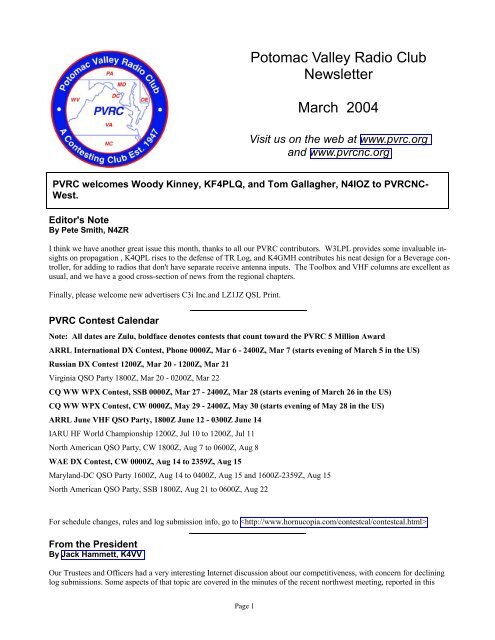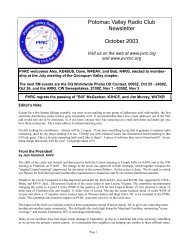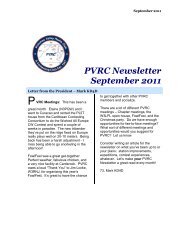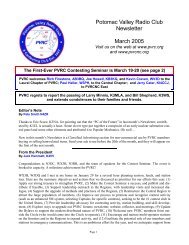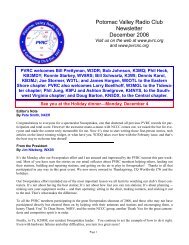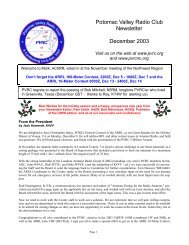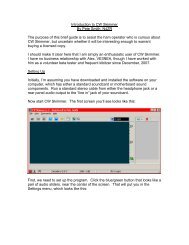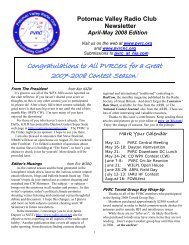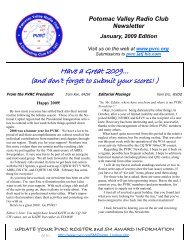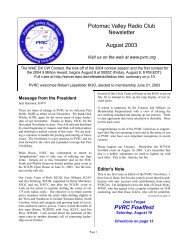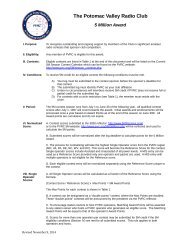PVRC Newsletter March 2004.pub - Potomac Valley Radio Club
PVRC Newsletter March 2004.pub - Potomac Valley Radio Club
PVRC Newsletter March 2004.pub - Potomac Valley Radio Club
Create successful ePaper yourself
Turn your PDF publications into a flip-book with our unique Google optimized e-Paper software.
<strong>Potomac</strong> <strong>Valley</strong> <strong>Radio</strong> <strong>Club</strong><br />
<strong>Newsletter</strong><br />
<strong>March</strong> 2004<br />
Visit us on the web at www.pvrc.org<br />
and www.pvrcnc.org<br />
<strong>PVRC</strong> welcomes Woody Kinney, KF4PLQ, and Tom Gallagher, N4IOZ to <strong>PVRC</strong>NC-<br />
West.<br />
Editor's Note<br />
By Pete Smith, N4ZR<br />
I think we have another great issue this month, thanks to all our <strong>PVRC</strong> contributors. W3LPL provides some invaluable insights<br />
on propagation , K4QPL rises to the defense of TR Log, and K4GMH contributes his neat design for a Beverage controller,<br />
for adding to radios that don't have separate receive antenna inputs. The Toolbox and VHF columns are excellent as<br />
usual, and we have a good cross-section of news from the regional chapters.<br />
Finally, please welcome new advertisers C3i Inc.and LZ1JZ QSL Print.<br />
<strong>PVRC</strong> Contest Calendar<br />
Note: All dates are Zulu, boldface denotes contests that count toward the <strong>PVRC</strong> 5 Million Award<br />
ARRL International DX Contest, Phone 0000Z, Mar 6 - 2400Z, Mar 7 (starts evening of <strong>March</strong> 5 in the US)<br />
Russian DX Contest 1200Z, Mar 20 - 1200Z, Mar 21<br />
Virginia QSO Party 1800Z, Mar 20 - 0200Z, Mar 22<br />
CQ WW WPX Contest, SSB 0000Z, Mar 27 - 2400Z, Mar 28 (starts evening of <strong>March</strong> 26 in the US)<br />
CQ WW WPX Contest, CW 0000Z, May 29 - 2400Z, May 30 (starts evening of May 28 in the US)<br />
ARRL June VHF QSO Party, 1800Z June 12 - 0300Z June 14<br />
IARU HF World Championship 1200Z, Jul 10 to 1200Z, Jul 11<br />
North American QSO Party, CW 1800Z, Aug 7 to 0600Z, Aug 8<br />
WAE DX Contest, CW 0000Z, Aug 14 to 2359Z, Aug 15<br />
Maryland-DC QSO Party 1600Z, Aug 14 to 0400Z, Aug 15 and 1600Z-2359Z, Aug 15<br />
North American QSO Party, SSB 1800Z, Aug 21 to 0600Z, Aug 22<br />
For schedule changes, rules and log submission info, go to <br />
From the President<br />
By Jack Hammett, K4VV<br />
Our Trustees and Officers had a very interesting Internet discussion about our competitiveness, with concern for declining<br />
log submissions. Some aspects of that topic are covered in the minutes of the recent northwest meeting, reported in this<br />
Page 1
newsletter. More dialogue and leadership actions will be needed.<br />
I have seen a lot of <strong>PVRC</strong> people this month. We had a big turnout at the Central meeting for the N1MM Logger program<br />
by N4ZR. The Northwest meeting was very lively and interesting. I had the pleasure of operating with Bill, W4RM, and<br />
admiring his maturing Multi-2 station. I visited Bob, W4MYA and toured his impressive station as he reconfigures from<br />
the multiple operator configuration. I had some time with Mike, W0YR who is preparing to deploy for several years to<br />
lead a broadcasting business in eastern Europe. I had some interesting time in the car with Pete, N4ZR discussing his<br />
many projects.<br />
We have a very diverse and talented membership. Some are building, others are trimming back, and some are moving.<br />
Some are excited by the traditional contests, and others are turned on with the wide open rush of the WPX, or the one direction<br />
focus of a Europe contest, of the weak signal challenges of the 160M or VHF/UHF contests, or on the thrill of<br />
working an expedition. Variety of interests!<br />
The contesting column by John Dorr, K1AR in the <strong>March</strong> 2004 CQ Magazine is recommended reading. His topic is "Are<br />
We Having Fun Yet?" His point of view rings very true with me, and may be an articulate case for why our club may<br />
serve our members better by supporting and encouraging a very diverse range of contesting activities, as we seem to be<br />
doing in recent years. <strong>PVRC</strong> members are showing up in the top ranks. See the recent WPX results. We are growing<br />
stronger in VHF, in RTTY, and others. Let's celebrate our varied interests, and continue to pull together our strength for<br />
the major contests.<br />
The Mid-Latitude Trough and its HF Propagation Effects<br />
By Frank Donovan, W3LPL<br />
We often experience brief European openings on 40 meters at night as the solar flux drops as we approach solar cycle<br />
minimum. This same phenomenon also causes the sudden loss of propagation on the higher bands as night-time arrives<br />
over the north Atlantic and north Pacific. It also causes the disappearance of our sunrise opening to Japan on 20 meters.<br />
The loss of propagation that often (but not always) impacts north Atlantic and north Pacific night-time propagation is<br />
caused by an electron depletion region in the F layer ionosphere known as the mid-latitude trough. The mid-latitude<br />
trough is primarily a night-time phenomenon that occurs almost exclusively during the winter and the equinoxes. Summer<br />
occurrences are very rare. The pole-ward wall of the mid-latitude trough is bounded by the low-latitude boundary of the<br />
auroral region. The width of the mid-latitude trough is typically five degrees or more, extending towards the equator from<br />
its pole-ward boundary with the aurora. During the night, the equator-ward edge of the mid-latitude trough steadily drifts<br />
to lower latitudes. The mid-latitude trough disappears by re-ionization when the sun rises over that part of the ionosphere.<br />
During the onset of increased geo-magnetic activity, the low-latitude edge of the auroral region rapidly shifts towards the<br />
equator. Consequently, the entire mid-latitude trough also shifts toward lower latitudes and propagation to Europe and<br />
Japan is likely to fail completely.<br />
What does this mean for upcoming ARRL DX contests? 40 meter propagation to Europe on 40 meters will be best during<br />
the hours near our sunset. Propagation to northern Europe will fade away within an hour or two after sunset, and only the<br />
southern tier of Europe may be workable by as early as 0100Z. Europe will often fade away by 0200Z, except for skew<br />
paths toward the south-east and south. On many (but not all) nights, propagation will return briefly during the hours near<br />
European sunrise, as the mid-latitude trough is re-ionized by the sun. Propagation to Europe will last longer into the night<br />
in North Carolina and Virginia than it does in New Hampshire and Massachusetts. Similarly, 15 meters will lose propagation<br />
to Europe shortly after European sunset, and 20 meters will lose propagation to Europe soon thereafter. On paths to<br />
Japan, direct path 40 meter propagation towards the northwest is unlikely except for a very brief period at 0800Z<br />
(Japanese sunset) and during the hour so around 1130-1230Z (our sunrise). During the remaining hours, propagation to<br />
Japan will be over the familiar (to 40 meter DXers) southwest skew path.<br />
On 15 and 20 meters, evening openings to Japan will be brief, beginning shortly after 2130Z (sunrise in Japan) , and failing<br />
shortly on 15 meters after our sunset and soon afterwards on 20 meters. The morning 20 meter direct path openings to<br />
Japan we've become used to on 20 meters during high sunspot years will be only a distant memory as the mid-latitude<br />
trough kills that path during the Japanese night-time hours.<br />
The mid-latitude trough can be very beneficial on long haul 160 meter paths at sunrise on the eastern end of the path.<br />
Ionospheric tilts occur in the vicinity of the trough, occasionally producing tremendously enhanced 160 meter propagation<br />
at our sunrise on our path to Japan. I've experienced several JA sunrise openings when the JAs are an honest "20 meter<br />
Page 2
S9". It's amazing to listen to their S3 signals build up to S9 over about a 5 minute period, stay at that strength for 10-15<br />
minutes, then steadily fade away as absorption takes over with the rising sun. On those occasions I've had runs of 20 or<br />
more JAs on 160, just as on 10 meters when propagation is good. Fig 1.6 at http://www.radtelnetwork.com.au/<br />
propagation/hfprop.htm shows an illustration of the MUF at the mid-latitude trough. Although the article says the midlatitude<br />
trough occurs at 60 degrees north and latitude, recall that it's occurs during winter and in the vicinity of the equinoxes,<br />
so you would rarely experience a mid-latitude trough simultaneously at both north and south latitudes.<br />
As we approach solar minimum, we should be prepared for shorter openings over the north Atlantic and north Pacific<br />
paths. Knowledge of propagation phenomenon will be more of a strategic advantage than during the high sunspot cycle, as<br />
openings become more fleeting. Operators who are aware of these patterns will be less likely to be disappointed by<br />
missed opportunities.<br />
The Toolbox<br />
By Don Daso, K4ZA<br />
Recently, one of the locals was wandering around my QTH (we were supposedly searching for some aluminum tubing<br />
from the K4ZA stockpile), when the subject shifted to the base of my 10 MHz vertical.<br />
“Where’d you get that beautiful ground ring?” he asked.<br />
Naturally, I was surprised and delighted that someone would<br />
think that something I’d made would be beautiful, especially<br />
considering this antenna was constructed completely from castoff<br />
pieces, parts, and scrap.<br />
But I realized the ground ring might warrant a few comments,<br />
considering how several other people have now heard about it,<br />
and have also asked me for details.<br />
Basically, the ring, or plate, is one half of what’s known (in my<br />
industry—film and video production) as a 1-inch (Type C)<br />
videotape reel. One-inch videotape typically comes in 34-<br />
minute, 66-minute, and 96-minute lengths, spooled on to aluminum<br />
reels that simply look like larger versions of old reel-toreel<br />
audio tape. Really, that’s a good comparison; the only significant<br />
difference is in their hub construction (audio reels typically<br />
spin apart, while the video reels are screwed together). Since the advent of Betacam and other cassette-contained<br />
videotapes, 1-inch popularity has steadily declined. So much so that many production companies and post-production<br />
houses have taken to throwing out their old 1-inch tapes. And while the old oxide-based tape itself isn’t real valuable,<br />
I’ve always felt the reels would or could be, and have saved them whenever I could.<br />
So, one day, while looking at the Lance Johnson Engineering GP-1 ground ring, it occurred to me that I could simply take<br />
a 1-inch reel apart, throw away the hub, drill some appropriately-spaced holes around the perimeter of just one of the aluminum<br />
reels, and voila, I’d have my own no-cost version of this handy item.<br />
The reels are usually made of a hard alloy (not unlike 6061-T6), and are usually from 6 inches to 12 inches in diameter.<br />
The hub opening is 3.5 inches. A few minutes with a drawing compass will give you perfectly spaced and aligned hole<br />
locations. A few more minutes with a center punch & a sharp drillbit and you have a very neat ground ring base. A photo<br />
of one such ring is included (see above). I usually drill holes both on the perimeter edge and then further “inside” the perimeter,<br />
allowing me to attach more radials at a later date, or to facilitate different lengths or sizes of wire. I usually use<br />
stainless bolts or machine screws to attach the terminals, using Penetrox at each connection.<br />
A few minutes with such reels will provide you with a unique and useful tool. I’m sure you can think of a myriad of uses<br />
for these “junk” pieces yourself. (For instance, fastening aluminum angle to the plate with an SO-239 mounted on it for<br />
the vertical element, and so on. There’s something neat and clean about having the radial attachment as a circle, too!)<br />
I was pleasantly surprised to receive so much attention from last month’s column. Along with requests from clubs and<br />
groups to reprint the note, along with lots of e-mail traffic (only one was negative, by the way!), and then a note from the<br />
Page 3
League saying they’d print the tip in “Hints and Kinks,” which was a treat. I hope this month’s column meets with similar<br />
reactions.<br />
What have you made using trashed items; what recycled gems can be found in your Toolbox?<br />
VHF and Above <strong>Radio</strong> Frequencies<br />
Once thought of as useless, now one of the most sought after resources in the world … use them or<br />
lose them!<br />
By Chuck Watts, W4XP<br />
The East Tennessee DX Association (ETDXA) is sponsoring the 2004 Spring Sprints. The ETDXA is also collecting and<br />
compiling scores for the Sprints. As the cliché’ says, “if all goes according to plan,” I should have my newly acquired<br />
Rohn 25G tilt-over tower installed in time for this year’s Sprints and I plan to be on in all of them, even if it’s just for a<br />
portion of the contest period, to show support for the ETDXA efforts in keeping the VHF and above Sprints alive.<br />
These Sprints are the perfect time to check out how well your VHF and above antennas survived the winter. And it may<br />
be the first time you’ve fired up that amplifier and you will have to “cook” out, literally, the bugs that found their way into<br />
the hardware. I’ll have the opportunity to try out my “new” 8874 amplifier on 222 MHz and see if the capacitors in the<br />
power supply of my modified DTR-2000 will explode when I fire up for the 50 MHz Sprint!<br />
The rules for all of the band sprints are the same and are available at: http://www.etdxa.org/2004_spring_sprint%20rules.<br />
htm. Put the dates for the 2004 Sprints on your calendar! Here are the times for the bands:<br />
The 144 MHz Sprint will be from 7 PM until 11 PM local time on Monday (April 5, 2004).<br />
The 222 MHz Sprint will be from 7 PM until 11 PM local time on Tuesday (April 13, 2004).<br />
The 432 MHz Sprint will be from 7 PM until 11 PM local time on Wednesday (April 21, 2004).<br />
The Microwave Sprint will be on Saturday (May 1, 2004) from 6 AM until 1 PM local time. This includes all Amateur<br />
frequencies above 902 MHz. Please include band data in summaries and logs. NOTE: use of Liaison Frequency is encouraged.<br />
And the last band,<br />
The 50 MHz Sprint will be from 2300Z Saturday until 0300Z Sunday (May 8& 9, 2004).<br />
Exchange: Call sign and 2x1 degree grid-square locator. As in most VHF+ contests, signal reports are optional; QSO<br />
Points are 1 point per QSO. The total score is QSO points x grid squares. Rovers score same, but please segregate logs<br />
by grid. Scoring for Rovers is cumulative, total number of grids worked from each grid activated multiplied by total number<br />
of stations worked in each grid activated. Logs due 4 weeks from the end of the contest in ARRL VHF contest format.<br />
After the Sprints comes the ARRL June VHF QSO Party. The “granddaddy” of VHF Contests, not because of the number<br />
of participants, but because this is a contest where your score can be affected by more factors than can be thoroughly discussed<br />
here. Possibly the most influential factor is E-layer reflection (E skip or Es), or more likely the lack of Es propagation.<br />
If there is significant Es it is usually most beneficial for the folks located in the Midwest or extreme Southeast.<br />
However, it is not uncommon for significant Es “clouds” to form over the Northeast, too.<br />
Another common summer time propagation is the inversion, especially the coastal form. Stations located along both<br />
coasts can see significantly long paths, Maine to Florida, as an example for the East Coast, California to Hawaii or Northern<br />
California to the Baja Peninsula for the West Coast. Stations at higher elevations sometimes will not benefit due to<br />
the fact that these locations can be above the inversion layer. A quick check of the Aviation weather forecasts for a day or<br />
two before and through the contest period will yield some insight into the temperatures aloft. Sites like http://<br />
aviationweather.gov/ will give both surface and upper atmosphere temperatures and winds. Knowledge of both temperatures<br />
and winds are important in predicting Es and inversion activity.<br />
Two other propagation modes experienced in the June VHF contest are, rarely, aurora and, almost always to some degree,<br />
Page 4
tropospheric. There are two great tools to aid operators in assessing the likely hood of either mode occurring. William<br />
Hepburn's tropospheric maps for North America and various parts of the world is one. These maps show potential tropospheric<br />
openings for various continents of the world. William updates these himself, and attempts to show 3-day forecasts<br />
http://www.iprimus.ca/~hepburnw/tropo.html. The other tool is useful in predicting the likelihood of aurora. At http://<br />
spaceweather.com/. A typical Watch report looks like this:<br />
AURORA WATCH: Earth will run into a solar wind stream on or about Feb. 29th, and that could spark auroras.<br />
The best displays will be at high latitudes--e.g., Alaska, Canada and Scandinavia.<br />
Spectacular photographs of aurora by visual observers frequently accompany these reports. Check these sites out and see<br />
what is available. It should be obvious that some of the information is applicable to HF contesting as well as VHF+ activities.<br />
There is, on several Internet SIG (Special Interest Group) Reflectors, a vigorous discussion in progress debating proposed<br />
changes to ARRL sponsored VHF and above contests. At this writing nothing is “solid” as to what changes will be imposed,<br />
if any, this year. I’m certain that W3ZZ is an informed source on this subject, and Gene will have something in a<br />
future World Above 50 MHz column in QST. Proposed changes in the VHF+ contests will affect the club competition<br />
category as well as individual and multi-operator groups.<br />
The original e-mail that started the discussion is too long to reprint here, but if you’re interested send me an e-mail and I’ll<br />
forward it. I should be able to present a summary of the proposal, and some alternatives presented by the VHF community,<br />
in the April column.<br />
If you have suggestions or comments, please contact me at w4xp@arrl.net or send me a message via the DXCluster.<br />
TR-LOG -- Dynamite or Dinosaur?<br />
By Jim Jordan, K4QPL<br />
My first thought was to write another one of those AMine is best@ articles. Thinking better of it, this would be unfair to the<br />
talented amateurs who invest countless hours fulfilling the essence of amateur radioBinnovation and experimentation.<br />
Writelog, MM, TR, CT, NA, MTTY, etc., are all great programs which would never have been written by anyone motivated<br />
entirely by profit. Likewise, I don=t believe there is a Abest@ logging software for every mode and environment. The<br />
well rounded contester should probably have two or three different programs on hand. How many golfers use just one<br />
club?<br />
For CW contests, SO1R and especially SO2R, I think TR-Log, written and supported by ATree@, N6TR, has reached a<br />
state of refinement, flexibility, and reliability nothing else can match. Old technologyBsure. But like a classic car or good<br />
red wine, it just gets better with age. And like those, it must be given care and TLC to be fully appreciated.<br />
First, match TR up with the environment it was written for. It=s not network-ready and it won=t like your new Pentium<br />
giga-whatsis with Windows XP. Find a 486 or higher DOS machine from the mid 90's. They can be picked up for next to<br />
nothing or Aliberated@ from your office store room. A late version of DOS is best, maybe 6 or 7. While you=re at it, add<br />
another parallel port. Pull out unnecessary cards, especially modems, sound and network cards and anything else which<br />
will hog the interrupts. All you want are good COM1, COM2, LPT1 and LPT2 ports. Disable those phantom COM3 and<br />
COM4 assignments. For two serial interfaced radios and packet, however, you may need a third true COM port. If you<br />
have an old Epson printer for your QSL labels, so much the better. Don=t forget a PATH statement in your config.sys file<br />
for C:\LOG which is where you install the program. Add serial interface cables to match your radios. I recommend wiring<br />
up one of the parallel cables with both the CW output plug and a jack for your paddle. Schematic is in the manual. You<br />
can build it into the plug or in a separate box. If you don=t have room for an extra monitor and keyboard, a KVM switch<br />
might be a good idea.<br />
Install, but don=t just wait for pretty pictures. With standard defaults, you=ll be less than satisfied. Tree does give the option<br />
to just step through and start contesting. That can be misleading as you might then think you know this beautiful program.<br />
Open the hood, understand the capabilities, read the manual and keep it close by. Update the manual from the<br />
READ.ME file in each upgrade. Alt-H and Ctrl-J give limited on-screen help and customizing options, but using a text<br />
editor to customize your config files is where you find the gold.<br />
Page 5
TR-Log is like CW itself. It takes skill and practice to do well, but once mastered, is reliable, provides lots of real-time<br />
data and lets you concentrate on the contest. For SO2R, TR really is dynamite. When you finally get the nerve to turn TR<br />
loose in full interfaced two-radio mode, it is awesome! While one radio is sending CQ; you dupe check on the other radio;<br />
If not a dupe, TR holds the call in a small window. When there=s a break in your run, hit the key and hang on. <strong>Radio</strong> 2<br />
drops your call; <strong>Radio</strong> 1 restarts to hold the run frequency; <strong>Radio</strong> 2 goes into exchange mode, logs the mult and <strong>Radio</strong> 1<br />
is running again in half the time I can describe it. No tricky key strokes and no snafu=s. With TR as your keyer, the paddle<br />
halts the program and lets you greet a friend, react to the unexpected and simplify fills. Great in a pileup to kill the QSL<br />
and catch a tailender.<br />
In addition to rock solid reliability, flexibility and customization are major strong points. Every TR user sets up differently.<br />
To save time, you can type all your station parameters into one subfile (ports and commands for interface, paddle,<br />
cw output, band output, PTT etc.) as well as any of the huge variety of available preferences. That file gets Acalled@ by the<br />
specific contest file. For example, with the text editor type AINPUT CONFIG FILE = C:\LOG\K4QPLCW2.CFG@. Create<br />
folders for each contest. Use a system like C:\LOG\CONTESTS\ARRLDX and then when you set up ARRL DX,<br />
name the contest file something like 04FEBCW.CFG. Insert your contest-specific variables in that file after calling your<br />
station parm file. Next year, just do a ACOPY 04FEBCW.CFG 05FEBCW.CFG@ command and you=re ready to roll with<br />
no new setup at all. Your data files will also be given the new name. Chances are that upgrades will not upset existing<br />
commands. The TR Contest library is huge. Post contest routines include Cabrillo conversion.<br />
The variety of customization is endless. For example, I don't number my radios. They're port and starboard, red and green.<br />
I color code and name TR screens for each radio along with red and green LED's for audio and on-air indicators and colored<br />
tape for cabling. Surprisingly useful at 3:30 a.m. Bandmapping for S&P is brilliant with choices for one band, all<br />
bands, radios, guard bandwidth, colors, decay rate, etc. Jump your cursor to the band map to check back on a pileup when<br />
you don't want to wait. There's also a Visible Dupe Sheet in colored columns by call areas which is particularly good for<br />
Sprint where normal bandmapping is useless. Speaking of Sprint, TR is totally intuitive, alternates modes and warns if<br />
you fail to QSY.<br />
Another cool feature is using the left and right shift keys to tune the VFO in S&P and slew the RIT when running. (RIT<br />
slew not available for all radios.) A character insert in your exchange recenters the RIT after each QSO. I've done a Sprint<br />
and almost never touched the radio at all. Enter a specific frequency in the call window and you're there. Great for NAQP<br />
QSYs. You can also vary the CW speed of the components, like your call, within the exchange message itself.<br />
I could go on forever. Bottom line, if there's a parameter you want to change, you probably can. Keyer attributes and keyboard<br />
sending, of course. Delay and hang times to assert PTT to the linear, sure. QTC's, SCP, data base calls, customized<br />
F-keys, absolutely. Or create an Alt Function set for the second radio. After editing the program, delete the restart file<br />
with the DOS command DEL *.RST@ so your changes will take effect when you restart.<br />
Speaking of restart, TR is superbly fail-safe. Critical data is backed up after every QSO. Power blink, or the cat yanks the<br />
line cord, no problem. You can also backup to floppy every nn QSOs just in case Murphy attacks your hard drive during<br />
the contest.<br />
If you're strictly a Plug and Play type, go with Writelog and accept the compromises that are inherent with simplicity. But<br />
if you like to learn and to optimize your interface controls and logging, you'll have fun with TR, you'll up your rate and<br />
lower fatigue. Print out the manual, it's definitely worth the paper and ink. Buy the annual support and upgrades. Reasonable<br />
and you'll see just how great the support is. Several upgrades will be e-mailed to you each year. More help is on the<br />
TR list-serv. Customizing TR is a great way to spend a winter's evening preparing for a contest. Besides, it's a heck of a<br />
lot warmer than climbing towers or slinging wires!<br />
Questions or need help? E-mail me -- K4QPL@nc.rr.com<br />
Don't miss this year's remaining 5M Contests --<br />
ARRL DX Phone <strong>March</strong> 6-7... Russian DX <strong>March</strong> 20-21... WPX Phone <strong>March</strong><br />
27-28…WPX CW May 29-30...ARRL June VHF QSO Party June 12-14<br />
GO <strong>PVRC</strong>!!!<br />
Page 6
Beverage Antenna Controller<br />
By Mike Sims, K4GMH<br />
For those of us with radios that don't provide a receiver only antenna input, the schematic shows my way solving this<br />
problem. In addition, the circuit keeps me from transmitting into one of the Beverage antennas. Also, Beverage antenna<br />
selection was incorporated. With the constructed circuit, the receiving Beverage antennas at K4GMH are selected and<br />
automatically switched in during receive without the possibility of transmitting into one of them.<br />
The relays used are P&B RTE24012F. They are "overkill" for this application as these are the same type used in my various<br />
remote antenna switching projects. The relays will pass 1500 Watts to a nominal 50 Ohm load when wired as a SPDT<br />
and cost less than $3.00 each. The diodes are 1N4001. The switch is a DP3T, but should be selected for your application.<br />
In my case, the switching arrangement is used to select West or Northeast Beverage antennas. One set of contacts on<br />
RLY1 is used to key my amplifier. This latter feature isn't part of the automatic receive antenna selection, but the set of<br />
contacts on RLY1 were available.<br />
This Just In … YI3DX (W3ICM) Dishes Out the RF in Baghdad<br />
As you can see, Fred's shack arrangements have a certain<br />
temporary feeling to them, but he's there for the<br />
deserving. Better get him before June 30!!<br />
Page 7
<strong>Club</strong> Victory in WPX<br />
By Bob Dannals, W2GG<br />
WPX CW scores are out. Congrats to everyone for a club victory. We were #2 US to NCCC but since NCCC won world,<br />
we were awarded #1 US.<br />
Also, congrats on World #1 finish to M/M NY4A (N4AF and team) and #1 USA M/2 to KM4M (K4JA and team).<br />
Plus USA SO Assisted #1 to WM4RM (W4RM), #5 K3KO, #9 K3WA, and #15 W3HVQ.<br />
USA SOAB LP #3 to NY3A, #9 WJ9B, and #15 N4YDU.<br />
USA SOAB HP #6 to W4MYA, #12 K3ZO, and #14 WR3Z.<br />
USA #1 Tribander/Single Element to K2PLF and #7 N3UM.<br />
USA Rookie #1 to AI3M.<br />
USA #1 21 MHz to KD4D and USA #10 14 MHz to N8II.<br />
And #1 QRP 14 MHz to WA8WV.<br />
Around the <strong>Club</strong><br />
Meeting minutes from the regions<br />
<strong>PVRC</strong>/CVCC Jan. 13, 2004<br />
The regular monthly meeting of the CVCC at Henrico Doctors’ Hospital,<br />
Parham Road Campus, was called to order at 7:03 PM by president Roy Davis, Wk4Y. Eighteen members and guests<br />
were present. Members and guests introduced themselves. Bob, W4MYA, announced that there would be no more multistation<br />
contests from his place. Bob, W4MYA, presented the program for the evening - a video of the July 2002 World<br />
<strong>Radio</strong>sport Team Championship (WRTC) contest held in Finland. Participants drew envelopes at random to determine<br />
their QTH, host and referee for the contest. All teams have identical antenna systems, but other equipment is up to the<br />
team. About 80% used Yaesu 1000MP or 1000D transceivers. Referees called in scores every hour via text messaging.<br />
There was concern if realtime scores and posting on the internet could<br />
bias competition.<br />
Items of business:<br />
FrostFest will be February 22. Order VIP tickets online. Volunteers are also needed and appreciated. Ed Moore, NW4V,<br />
is chair for nominations for club officers. Nominations will be made in <strong>March</strong> and voting will be done in April. Tom,<br />
N4ZJ, can no longer edit the newsletter. Send band entity update to John, w4tnx@comcast.net. List numbers by band -<br />
160 - 6M, indicating 0 if none for a band. Packet cluster news - new AR callsign database was installed. Show/ham gives<br />
QSL information. Show/wx zipcode gives live weather for area. A motion was made by Dennis, N4DEN, to donate $100<br />
to QSL.NET. AC, W4HJ seconded the motion, and the motion carried. Ralph, N4EHJ, suggested that we hold a contest<br />
club net and suggested using the 146.58 or asking MRA for a night.<br />
Marie Long, K4KML, Secretary<br />
Laurel Chapter, January 28, 2004<br />
The following members were in attendance: KB3BWR Toby Widdicomb, WI3N Jim Cross, KT3D Dennis Fitzgerald,<br />
N3TZA Joe Craven, KA8YPY Dan Blasberg, WV3D Kevin Craven, and N3XL Bill Smith. Ed Herbrechtsmeier,<br />
KB3KQX visited and expressed interest contesting. He is setting up his shack now.<br />
The useful and entertaining ARRL Contest Rate Sheet by Ward Silver, N0AX, which is published weekly via e-mail, and<br />
free for ARRL members, was pointed out to the membership. Using contests and QSO parties as a method for obtaining<br />
rapid fire contacts for awards, as well as for <strong>PVRC</strong> points, was discussed. CW contesting and training techniques were<br />
Page 8
discussed. Bill pointed out that by creating a file of callsigns you can use G4FON's Koch Method Trainer as a way to<br />
practice simulated runs. The spacing used between the callsigns will determine how fast the next call is sounded. This way<br />
you can give yourself a little time to make the log entries between calls, just as you would in a contest.<br />
Bill Smith, N3XL<br />
Southern Maryland, February 5, 2004<br />
In attendance were the following members: Barry WR3Z, Wayne N1WR, Mark KD4D, Tom K3DSP, and Marty<br />
W3YOZ. Guests included Gene Talley N3NO + XYL Suzanne N3JTR, Dave Craig N3DB + XYL Lisa and newborn<br />
Matthew.<br />
A break in the poor WX of late was the perfect time for a dinner/meeting over on Solomons Island. With the emphasis of<br />
the dinner being a social gathering, recent/planned radio activities were discussed (especially VHF/UHF). Also, pictures<br />
from Barry and Rob ND3A’s vacation in Australia were passed around to the group.<br />
Barry WR3Z operated both CQWW contests as part of the M2 set-up at N4RV with considerable success. Barry also participated<br />
in the January VHF contest with the W3SO LM group in FN00 as one of the 6M ops, and plans to be back at<br />
N4RV for both ARRL DX contests.<br />
Wayne N1WR has had limited activity of late due to antenna problems resulting from Hurricane Isabel. Repairs have not<br />
taken place of yet due to a combination of the poor WX as well as recovery time from surgery. Wayne expects to work on<br />
the repairs once the WX improves.<br />
Mark KD4D operated at W3LPL for both CQWW contests as well as the 10M Contest. Along with his operating at<br />
W3LPL for the ARRL DX contests, Mark plans to operate as part of the K4JA team in WPX SSB and has looked in to<br />
operating up in VY2 for the WAE CW contest.<br />
Tom K3DSP has been the most active of the local members, with scores submitted for CQWW SSB, ARRL 10M, ARRL<br />
160M, and January VHF contests. Tom plans to operate in the upcoming major contests as time permits. Great job Tom!<br />
Marty W3YOZ made the trip down for several reasons, the two most significant ones being (1) a love of seafood, and (2)<br />
continuing his quest to be able to attend at least 1 <strong>PVRC</strong> meeting in every region. The trips most every weekend up to<br />
Altoona culminated with a pretty successful showing for W3SO in the January VHF Contest, with a LM score of 217K.<br />
This was despite an additional 6” of snow on top of +12” already on the ground. But Marty has been able to put together<br />
a group of operators, both local to Altoona and from afar (DC area, northern MD, and MD Eastern Shore), to now have a<br />
very competitive LM station. Marty does plan to take a little time off to continue his cleanup from Hurricane Isabel, but<br />
will otherwise maintain the W3SO station along with W3TEF, KD3SA and W3BTX to prepare for the June VHF contest.<br />
Both Gene N3NO and Dave N3DB have expressed interest in joining <strong>PVRC</strong>. N3DB, as many of you may already know,<br />
has become a very active 6M operator and has a wealth of knowledge of VHF/UHF operating and propagation techniques.<br />
Dave’s call sign is seen quite often in the VHF column of QST, and has operated both SO and LM in the recent VHF contests.<br />
N3NO, who by the way is N3DB’s father-in-law, just recently retired for the Patuxent River NAS (where WR3Z<br />
works) and, as an admitted casual operator, has quite an impressive station for his love of chasing DX.<br />
See you in the pileups,<br />
Barry, WR3Z<br />
<strong>PVRC</strong>/NC East, February 5, 2004<br />
Members Present: Guy K2AV, Jim K4QPL, Wes K4WES, Bob N2NFG, Tom N4TL, Jeff NX9T, Gary W2CS, Jim<br />
WW4M. Regrets: AD4L, AE4EC, K4HA and N4CW<br />
Chapter Business<br />
Guy opened the meeting at 6:40 and announced that the East/West Carolina get-together will take place Wednesday evening<br />
<strong>March</strong> 10 in Burlington (mid-way between the Triad and Triangle). This will be the <strong>March</strong> meeting for the NC-East<br />
group (no meeting on the 1st Thursday in <strong>March</strong>). In the future we'll hold these meetings biannually on the equinox (Guy<br />
must have some Methodist/ pagan thing going on). Details as the date approaches. I'm sure some of us will be interested in<br />
Page 9
carpooling. Contests coming up: CW Sprint, ARRL DX/CW, CQ 160 SSB, NC QSO Party<br />
Member News -- Ed AE4EC reported by email that he'd operated in "WAE both ssb and cw, ARRL SS both cw and ssb,<br />
ARRL 10M, CQ WW both cw and ssb and cq 160M cw. I plan to operate in the ARRL DX, CW and the CQ 160M SSB<br />
test this month especially if I can get a new inverted L up in time for the 160M test. Definitely hope to meet with the club<br />
in <strong>March</strong>." Guy K2AV has picked up an Alpha 76 PA from Ron N4XD & thinks it's a dandy rig. N4XD has replaced it<br />
with an AL 1200 so he can run power on 12m. Jeff NX9T had shoulder surgery since our last meeting (he's doing well)<br />
but still managed to operate NAQP, ARRL VHF SS, and CQ 160 CW. He is looking forward to the SSB Sprint this weekend<br />
and the upcoming CQ160 phone test as well as the others later next month. Jim WW4M helped Jeff N3NPQ put up<br />
his rocket launcher tower for the VHF January Sweeps. Jeff's now QRV on 6m, 2m, 220, 432, and 1296. Now if only<br />
there were someone to talk to on 1296 in Chapel Hill.… Jim K4QPL operated in NAQP and the 160 CW test and thought<br />
the conditions during the 160 contest were great. He's getting close to finishing his new garage / shack: the insulation is<br />
done and the drywall can go up when he inspection is completed. Tom N4TL made a contact in in the CQ 160 contest and<br />
brought his homebrew 160m preamp for show and tell. Bob N2NFG has not been active recently. He missed SS due to a<br />
broken leg and then Writelog bit him on the @#$* during NAQP (the RTTY window kept popping up). Good news: he<br />
moved into the new house which has a room dedicated to radio. Bad news: the landscapers landscaped right over his guy<br />
anchors, so now he'll need to replace them and since he can't relocate them he'll need to use concrete. Wes K4WES operated<br />
in the NAQP. Gary W2CS also made 1 contact in the 160 contest -- he worked N4AF using an 80m antenna. He also<br />
operated in the Sprint.<br />
Jim, WW4M<br />
Central Region, February 9, 2004<br />
The meeting was held Monday 2/9/04 at Anita's in Vienna, Virginia. (Having the Virginia meetings at Anita's is new,<br />
most of the attendees at the Virginia Central meetings were in favor of doing this. However, Anita's does like to have at<br />
least 20 diners to utilize the upstairs room, so it is unclear if the April meeting will be at Anita's or at the library. We will<br />
try to get that worked out ASAP and let everyone know.)<br />
The following were in attendance: Pete-N4ZR, Brian-N3OC, Jack-K4VV and guest Danny Jamison-AH6FX, Mark-<br />
KD4D, Bob-KC3VO, John-N3HBX, Paul-K4JA, Rich-KE3Q, Marty-W3YOZ, Jim-W4EE, Bob-KI3O, Steve-KB3KAQ,<br />
Eric-WD3Q, Jim-N3JT with guest Mark Clark-W4CK, Ron-N4MO, Bill-N3RR, John-N3AM, Marty-K2PLF, Ken-<br />
W8JVP, Ray-KT4W, Masa-AJ3M, and Dave-WR3L.<br />
N4ZR presented a Powerpoint demonstration of the N1MM Logger program that is available for free download. Pete's<br />
briefing is now available on the <strong>PVRC</strong> web site for download or (html) viewing at http://www.pvrc.org. Thanks to Pete<br />
N4ZR for coming all the way from WV to bring us the presentation, to Jack K4VV for making the arrangements at<br />
Anita's, to Bob KC3VO for bringing his PA system, screen, and projector, and to John N3HBX for bringing a backup<br />
projector.<br />
After the presentation, there were brief comments. Jack Hammett K4VV said that Pete Smith, N4ZR has volunteered to<br />
pull together ideas and approaches for needed revisions to the <strong>PVRC</strong> Bylaws including a revision to the decision-making<br />
process (given the nature of our regional club structure), membership requirements (two meeting requirement, once a<br />
<strong>PVRC</strong>er, always a <strong>PVRC</strong>er, etc.), and various types of meetings. Send your ideas to him.<br />
Rich Boyd, KE3Q, brought up the idea of splitting the Central Region into two parts, with separate meetings in Maryland<br />
and Virginia. We will look into this further. The next Central region meeting will be in Temple Hills, MD on Monday,<br />
<strong>March</strong> 8, 2004. Dinner beforehand at Topolino's around 6pm for those interested. It is anticipated the program will be a<br />
presentation from the ARRL on ham radio public service activities that <strong>PVRC</strong>ers could participate in, although the presentation<br />
is not confirmed yet.<br />
73, Brian N3OC<br />
Carroll County, Impromptu <strong>PVRC</strong> Work Session, February 14, 2004 WX3B<br />
In attendance: N3SB, NY3A, WX3B<br />
It was a chilly evening when N3SB knocked on WX3B's door at precisely 9:00pm as planned. Steve entered the house<br />
Page 10
with magnifying glasses, special glasses you wear, and other super small devices including some 50 ohm resistors. We<br />
had a mission: Repair the 6db attenuator on the new (used) 160 meter Kenwood TS-850SAT and perform two other upgrades<br />
at the same time.<br />
Steve, NY3A brought over a Delorme product which had maps with extreme detail of our surrounding topography. We<br />
spent a great deal of time looking at the elevation surrounding both NY3A and WX3B. Steve (NY3A) decided he needs<br />
about another 50 feet of tower to get rid of this hill he has 3 miles away, attenuating JAs by 10db or so.<br />
Meanwhile, N3SB pulled apart the 850 and removed one of the boards, turned it upside down, and exposed dozens of surface<br />
mounted devices. With a large magnifying glass, it became obvious that a resistor in question had been burned up (as<br />
suspected). We measured the resistance and it was open. Steve meticulously replaced the component and Jim is still in<br />
awe that anybody can work on something that small; it's a well known fact that Jim doesn't even like soldering up microphone<br />
cables!<br />
Next, Steve added the CW sidetone volume control for the 850. This is a relatively simple enhancement that brings the<br />
sidetone volume control up to the front panel monitor control. Last but not least, Steve defeated the 850's famous broadcast<br />
band (40 meters) attenuation circuit. The night was considered a wild success and Pizza was served as the reward.<br />
A hearty thank you goes out to N3SB for trading several hours of surface mounted hardware engineering for several slices<br />
of Pizza!<br />
Carroll County, January 31 & February 7th, 2004<br />
In attendance: N8II, K3ZE, N3KS, K3LP, W3ARS, N3FX, W3DF, WX3B<br />
Round II of the FS5UQ DX-Pedition preparations began at 9:00pm at WX3B. This time the weather cooperated, and everyone<br />
was able to participate. Jeff, N8II gets the award for the die-hard of the group; he traveled over 2 hours from West<br />
Virginia to meet everyone. Jeff is very excited about the upcoming trip to St. Martin.<br />
Al, K3ZE was the drink supplier of the evening (Soda - that is) and he enjoyed socializing with the group and hearing<br />
about the big plans. Al's announcement was that he had fallen in love....with the Icom 746! We're waiting to hear how that<br />
romance progresses.<br />
This was the first time I had the pleasure of meeting Kam, N3KS, though many of my friends have met him years ago.<br />
This will be Kam's first major contest DX-Pedition/Vacation.<br />
David, K3LP was helping Jim dust off his two Yaesu FT-1000MPs that had been involved in a massive construction project....a.k.a.<br />
the building of David's house. Once we established that the radios were configured identically, and neither<br />
had the 2.0khz SSB filters in them - the tests progressed and we pronounced both MP's ready for the contest - everything<br />
worked!<br />
Clint (a.k.a. "Bubba") W3ARS was so excited from his last trip to FS5 that he could hardly contain himself. He was the<br />
center of attention in the "let's get the computers networked" department. Well we ended up working for several hours trying<br />
to connect to the network...and it didn't happen. Fortunately, Clint figured it out later on in the week.<br />
Tony, N3FX was assisting in the "media conversion" project trying to get network drivers zipped up and on the net for<br />
Clint. Even though Tony is not part of the FS5UQ DX-Pedition, we put him to work just like he was.<br />
Dan, W3DF had another reason for visiting WX3B. Dan collected sample plans for WX3B's review for potential home<br />
building. Dan commented that the WX3B basement looked a bit different than it did at his last meeting. Dan also denied<br />
that he is interested in being WX3B's QSL Manager.<br />
In addition to testing out David's two Yaesu FT-1000MP's, we did some preliminary testing of the writelog network and<br />
David ordered a copy of the software for the upcoming trip. CW keying interfaces were also tested. At the end of the evening<br />
we admitted that another get-together was necessary to iron out all network related issues.<br />
Adventures in FS5UQ Preparedness Continued: February 7th at K3LP<br />
Page 11
In attendance: W3ARS, N3KS, WX3B, N3VOP, K3LP, Rebecca and Ryan<br />
The story continued at K3LP's house the following Saturday. This time the goal was to build some wire antennas, and to<br />
get the contest logging program writelog networked, tested, CW interfaces tested, etc. Murphy reared his head again, this<br />
time on Clint's notebook PC - when the parallel port was not recognizable. I've never seen this error before! The solution<br />
to this problem was to buy a USB to RS-232 interface and use a serial CW keying interface for that notebook. Clint and<br />
Kam worked through that themselves after this get-together.<br />
The other interesting problem took 2 people 2 hours before we gave up: we couldn't get Kam's Windows ME PC to network<br />
with the others. We gave up at about 2:00am and called it a night. Kam determined later that the Windows registry<br />
was at fault - and after a format to the C: drive and a re-load of Windows ME - the system came right up and networked<br />
like a charm.<br />
Mike, N3VOP won the "good sport" award of the evening since he patiently waited for Clint to stop fussing with PCs before<br />
car-pooling home with him.<br />
Thanks to David's Wife Rebecca for the great food (Meat-Ball Sandwiches & Drinks) and of course my personal highlight<br />
of the evening was holding Baby Ryan Colingham, only about 2.5 months old! Now if we can just get him to yell "K 3<br />
LIMA PAPA....LIMA PAPA.....LIMA PAPA!"<br />
These adventures underscore the importance of good planning - before you get to your exotic destination. Any one of<br />
these issues might have been unfixable in a remote location.<br />
Submitted by Jim Nitzberg, WX3B<br />
Northwest Region, February 17, 2004<br />
The NW Region met at the City Buffet in Frederick, MD. In attendance were W6NRJ, K3WC, K3TZV, N4MM, K8OQL,<br />
W2YE,K2PLF, W3KHZ, N3VOP, W0YR, K4VV, N3HBX, K3ZO, W3ZZ, W8ZA, WD3A and W3LL.<br />
Announcements:<br />
W3LL, Bud: Look for, work and spot our <strong>PVRC</strong> team in the ARRL DX CW Contest at FS5UQ - K3LP Dave, W3ARS<br />
Clint, N8II Jeff, N7DD Larry. Echolink Internet roundtable discussing ARRL CW & SSB contests will again be hosted<br />
by Pete, N4ZR at 8:30PM on 19 Feb. Connect thru WM3T. <strong>Newsletter</strong> Articles are needed for upcoming months. Submit<br />
to Pete, N4ZR - n4zr@contesting.com.<br />
N3VOP, Mike: Clint, W3ARS will be trying 6M EME on 50.190 Mhz at FS5UQ using WSJT (JT65B), a 5-7? el Yagi,<br />
847 Xvr + Amp. N4MM, John: Manassas hamfest will be held on 06 June. SE VHF Society will sponsor an award for<br />
working all EM grids. ARRL eliminated 3 awards for lack of interest: Friendship, Old Timers and Ragchewers <strong>Club</strong>.<br />
W3ZZ, Gene: Look for VHF Contest changes coming in 2005.<br />
K4VV, Jack: The Trustees and Officers had a lively Internet discussion about lagging <strong>PVRC</strong> competitiveness, based on<br />
some decline in log submissions. Jack said that he and the Regional Chairmen have the responsibility to address the issue.<br />
Comparisons were made to the early days where a champion made personal contact with every member to convey interest<br />
by the club in their individual participation. One example was SMC's effective president who is very involved in recruiting<br />
and contest participation. Our regions may be effective in providing social structure but may not have the "fire in the<br />
belly" for promoting contest participation. W2YE, Dick attributes this to our strong local club affiliations. Local clubs<br />
are also submitting scores with pressure on members to contribute to local clubs rather than <strong>PVRC</strong>. Local clubs look for<br />
notoriety through published results. N3VOP, Mike noted that the Carroll County ARC uses their club call for score submittal<br />
with affiliation to <strong>PVRC</strong>.<br />
W3ZZ, Gene commented that <strong>PVRC</strong> needs to decide where we want to compete. SS is an example where most have the<br />
capability to compete. He suggested a callup list of inactive members soliciting/pledging contest points. K4VV, Jack described<br />
the very diverse interests of the club members as a counterpoint to focusing on narrow interest sectors.<br />
W6NRJ, Jim suggested station owners encourage their use by inviting those who can't setup a station. Multi-single has<br />
Page 12
more potential for point generation than separate single stations. K3WC, Dusty suggested we encourage K3EAR to join<br />
<strong>PVRC</strong>. K4VV, Jack said that he had contacted the leader of the K3EAR station, with no interest found. He reiterated that<br />
the club regional leaders are not mobilizing the members to be competitive. K3ZO, Fred commented that there are those<br />
who say "if you think you can do a better job then go ahead". There hasn't been competition in the elections in a long time.<br />
W6NRJ, Jim suggested obtaining area cluster membership lists for soliciting invitations to operate at local stations.<br />
N3VOP, Mike hasn't seen <strong>PVRC</strong> put on "how to" demonstrations other than the N1MM demo. K2PLF, Marty suggested<br />
that as a club we should focus on three or four contests with an all out effort rather than spread our resources. W0YR,<br />
Mike noted that perhaps new members aren't given the club's expectations of them. The executive committee or steering<br />
committee should come out with a statement of expectations - like a preamble or credo or company mission statement.<br />
K4VV, Jack stated that the by laws are being reviewed, including membership requirements, dues, various types of meetings,<br />
and voting. K3ZO Fred said dues are a bad idea. W8ZA, Bob says participation at his multi-multi station is laid<br />
back but it's still difficult to get operators. Some may be afraid they are going to look bad.<br />
W3ZZ, Gene went into a great nostalgic contesting story ending with a lament that there are no more young hams.<br />
W0YR, K4VV, K3ZO and W3ZZ followed up with not to be missed stories of the past. K4VV, Jack noted that the NW<br />
meeting in Frederick has become the most well attended meeting in <strong>PVRC</strong>. However, the Central meeting last week<br />
outdrew NW attendance with Pete, N4ZR's N1MM logger presentation.<br />
The meeting was adjourned at 8:30PM with a good time had by all. The next NW Region meeting is Tuesday, 16 <strong>March</strong>.<br />
73, Bud Governale, W3LL<br />
The Over the Hill Bunch met at the College Park Holiday Inn at noon on February 18 for lunch. Those attending were<br />
Frank W3LPL, Tony K3WX, John N3AM, Bill W3AZ, Gene W3ZZ, John W3BE, Robert W2BZR, Lawerence W3GN,<br />
Fred K3ZO, and Larry WA3KOU. There were many simultaneous QSO's on various topics. A good place to get in training<br />
for the coming SSB CQ DX contest.<br />
C3i®<br />
Finest Quality, Superior Performance, Lowest Cost<br />
Call, FAX, E-mail or Order from our Web Site<br />
Our VHF and UHF Yagis are proven performers in Contest<br />
after Contest @ K8GP / FM08fq<br />
50 MHz through 1296 MHz<br />
GO WITH THE WINNERS<br />
VISIT OUR HOME PAGE TODAY FOR MORE DETAILED INFORMATION<br />
http://www.c3iusa.com<br />
1-866-229-2377, PIN: 4455<br />
Warrenton, Virginia<br />
Page 13
<strong>PVRC</strong> REFERENCE PAGE Please send corrections to the editor. <strong>March</strong> 2004<br />
<strong>PVRC</strong> OFFICERS:<br />
President K4VV Jack Hammett 540-882-3188 k4vv@aol.com<br />
VP-North N3OC Brian McGinness 301-924-1712 n3oc@wirelessinc.com<br />
VP-South K2AV Guy Olinger 919-362-9461 k2av@contesting.com<br />
Secretary W2GG Bob Dannals 410-472-2004 rfd@jhu.edu<br />
Treasurer WR3L Dave Baugher 410-DX1-WR3L dave@wr3l.net<br />
Trustees: K3MM KE3Q N3RR N4ZR W4MYA W4ZYT N4AF K4IQ ND3A W3PP N1KC<br />
<strong>PVRC</strong> Charter Members (* =SK) W3GRF*, W4AAV*, W4KFC*, N0FFZ*, W4LUE*, W7YS, VP2VI/W0DX*, W3IKN, W4KFT<br />
<strong>PVRC</strong> Reflector administered by N4AF , postings to (Members only, if your callsign<br />
is not part of your email address, send an email to n4af@qsl.net to subscribe.)<br />
<strong>PVRC</strong> Dues <strong>PVRC</strong> has no annual dues. Donations are gratefully accepted by the Treasurer, Dave Baugher WR3L, 615 Rockaway Beach Ave., Baltimore<br />
MD 21221. Please make your checks payable to <strong>PVRC</strong>.<br />
Autocall Column Editor is K3DI 410-757-6706<br />
W3LPL Glenwood MD 145.590,<br />
441.250<br />
WR3L Baltimore MD 145.610,<br />
440.950<br />
K3SKE Frederick MD 144.930,<br />
441.125<br />
PVDXSN Packet Network<br />
w3lpl.net W3IP Crownsville MD 145.570<br />
wr3l.net N3RR Rockville MD 145.510, 441.325<br />
W3YOZ West River MD 144.910<br />
W3TOM Acokeek MD 145.770 N1WR Lusby MD 145.690<br />
N4OHE Mt. Weather VA 145.710,<br />
446.025<br />
NE3H* Harrisburg PA 144.970<br />
W3BD S. Mountain PA 145.630 N4SR* Woodbridge VA 145.630<br />
W4XP Bull Run Mtn. VA 144.990 K4JA* Callao VA k4ja.c.crosslink.net<br />
W4ML Goochland, VA 145.09 dxc.w4ml.net<br />
Most of the system is sponsored by the <strong>Potomac</strong> <strong>Valley</strong> DX Spotting Network. Nodes with * are independently funded by each SYSOP,. The W4ML node<br />
is funded by CVCC.<br />
<strong>PVRC</strong> Meetings<br />
CENTRAL: The Central Meeting is always the second Monday (except June, July, and August) at 7:30 pm. The central meeting generally alternates between<br />
MD and VA locations. A pre-meeting dinner is usually held between 5:00 and 6:30 pm. Check via 147.000- repeater. VA LOCATION: The Patrick<br />
Henry (Public) Library, Route 123, Vienna, VA. MD LOCATION: Church of the Nativity (Episcopal), Route 5, Temple Hills, MD.<br />
Pre-MD meeting dinner at Topoleno's Restaurant about 6:00 or 6:30 pm.<br />
NORTHWEST: Chair: Bud Governale, W3LL, 410-666-9189. W3LL@arrl.net. Meets monthly the 3rd Tuesday. Informal dinner about 6pm; meeting at<br />
7pm at the City Buffet, 1306 W Partick St, Frederick, MD 301-360-9666. Rear of shopping center, behind Mountain View Diner.<br />
NORTH CAROLINA -- EAST: Chair: Guy Olinger, K2AV, k2av@contesting.com; Sec: Jim Price WW4M. POC's are K2AV and WW4M (h:919-362-<br />
4635, w:919-460-2991). <strong>PVRC</strong>/NC meets at 6 pm the first Thurs of each month, plus an additional meeting in April at the Raleigh Hamfest. For details see<br />
http://pvrcnc.org<br />
NORTH CAROLINA -- WEST (TRIAD): Meets the 4th Monday of the month at 7:00 PM at Cobalt's Elemental Eats and Drinks on Deacon Blvd. in<br />
Winston Salem. Ragchew at 6:30. Directions are available upon request. The chairman for the new <strong>PVRC</strong>/NC West chapter is Henry Heidtmann W2DZO,<br />
henry@summitschool.com and the secretary is Robert Whitaker KG4NEP, kg4nep@yahoo.com.<br />
TIDEWATER COLONY OF <strong>PVRC</strong>: This group now meets in conjunction with the Virginia DX Century <strong>Club</strong> at Ryan's Steak House, which is on Battlefield<br />
Blvd in Chesapeake, at the Battlefield Blvd South (VA 168) exit off I-64. The meeting is still the third Tuesday of every month. We gather for dinner<br />
around 1815-1830, with the meeting around 1915-1930. Contact W4ZYT at 757-457- 5181 or w4zyt@exis.net for additional info.<br />
SOUTHWEST VA: Coordinator: David Jones, N4JED, Vinton, VA 540-890-2034, N4JED@AOL.COM. Meetings begin at 6 pm at the Roanoker Restaurant,<br />
Roanoke, Virginia in a private room (ask at the desk if you have not joined us before).<br />
BWI: Weekly breakfast Wed at 7:00 AM at Basil's Deli Port on Elkrdige Landing Rd 1/4 mile South of Winterson Road 410-850-4333. Director: Ike<br />
Lawton, W3IKE, 410-263-2830. Sec: Howard Leake, W6AXX, 410-465-7008, w6axx1@starpower.net<br />
OVER-THE-HILL LUNCH BUNCH (VA DC MD): Meetings are held monthly at three locations: Falls Church VA (Parkview Marriot), Oxon Hill MD,<br />
and Beltsville MD. Meetings are announced by E-mail or by telephone. All members and non-members interested in membership are welcome. For<br />
information contact Ben Shaver, AA4XU, 703-534-4740 or Bill Leavitt, W3AZ, 301-292-5797.<br />
PENNSYLVANIA: Steve Cutshall, K3TZV, k3tzv@paonline.com, 717-763-0462.<br />
RAPPAHANNOCK: Steve Bookout, NR4M (ex-NJ4F) NJ4F@erols.com. Also, Larry Schimelpfenig, K7SV, k7sv@va.prestige.net<br />
OCCOQUAN: Jack O'Mara W4NF, H:703-791-3302 W:703-739-7636 w4nf@comcast.net and Cliff Deel W4CE, w4ce@aol.com 703-491-0841<br />
CENTRAL VA: Pres: Roy Davis, WK4Y rdd2@verizon.net (804-741-9315). Sec: K4KML Treas: W4NM Meetings are held on the second Tuesday of the<br />
month at 7:00 PM at the Henrico Doctor's Hospital, 7700 Paraham Rd., Richmond, VA. To the right of the main entrance is a second entrance. Go through<br />
that door, turn left through that door and the cafeteria is the first room on the right. There will be some who meet at Nick's Roman Terrace, Westlands Shop-<br />
Page 14
ping Center, West Broad Street starting at 5:50 PM for dinner before the meeting. Talk-in available on 145.430<br />
SOUTHERN MD: Chair: Barry Shapiro, WR3Z. H:301-862-2466 barry.shapiro@navy.mil Meetings held at the home of N1WR.<br />
EASTERN-SHORE (DEL-MAR-VA): Dallas Carter, W3PP 302-875-0550 ludal@dmv.com<br />
SHENANDOAH: Bill Hinkle KV3R kb3aug@juno.com 304-567-3138<br />
CARROLL COUNTY: Jim Nitzberg, WX3B.410-374-9233 nitz@selectsa.com<br />
LAUREL: Pud Reaver W3YD preaver@earthlink.net Laurel Region meets concurrently with the Laurel Amateur <strong>Radio</strong> club at the first LARC meeting<br />
of each quarter.<br />
NORTHEAST: WR3L Dave Baugher 410-DX1-WR3L dave@wr3l.net<br />
ANNAPOLIS: Dick Wilder, K3DI 410-757-6706<br />
Your advertisement could be<br />
appearing in this space.<br />
<strong>PVRC</strong> represents a highlyselect<br />
group of hams who invest<br />
significantly in their stations<br />
every year.<br />
This <strong>Newsletter</strong> goes every<br />
month to over 600 of them.<br />
Contact WR3L or N4ZR for details.<br />
THE R. F. CONNECTION<br />
"Specialists in RF<br />
Connectors and Coax"<br />
213 North Frederick Avenue<br />
Suite 11-F<br />
Gaithersburg, MD 20877<br />
Tech Support:<br />
301-840-5477<br />
24-hour Fax:<br />
301-869-3680<br />
Order line:<br />
800-783 -2666<br />
Email: rfc@therfc.com<br />
Please visit us at:<br />
Http://www.therfc.com<br />
Our catalog includes:<br />
<strong>PVRC</strong> QSLs by LZ1JZ QSL-PRINT<br />
http://www.qsl.net/lz1jz<br />
E-mail:LZ1JZ@MAIL.COM<br />
UHF Series, N Series, BNC Series,<br />
Adapters, F Series, DIN<br />
Plugs, Portable <strong>Radio</strong> Power,<br />
DIN Plugs, Hardline Connectors,<br />
Audio Connectors, Microphone<br />
Connectors, FME Series, SMA<br />
Series, Reverse Thread SMA<br />
Connectors, MCX Series,<br />
MMCX Series, Adapter Kits, Reverse<br />
Polarity (TNC, N, SMA),<br />
39 coax types and 5 balanced<br />
lines<br />
Page 15
Page 16


